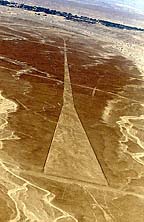The Mysterious Nazca Lines
The Great Nazca Line Drawings, in Peru
Is located from a short distance from the Pacific Ocean along the
Peruvian foothills of the Andes Mountains is the ancient city of Nazca where
one discovers the Palpa Valley. This valley, a region stretching 37 miles,contains
some of the most erplexing and quite amazing lines -- geometric lines, some
parallel, others intersecting, and still other surrounded by trapezoidal
designs. In the past, these drawings have been associated with the Inca
empire as Nazcan pottery and ceramics were found dotting the landscape.
Unfortunately, throughout this 37 miles of archeaological wonder, none of
the geometric shapes and gigantic pictures can be directly attributed to
the Inca culture. Traditional archaeologists do not recognize that the Inca
and pre-Inca people had accurate surveying skills.
Why these drawings were made remains unanswered to cultural-anthropologists
and archaeologists alike. Even the question, how these drawings were constructed
is a mystery. If iron was used, there has been no evidence unearthed, and
probably won't be. Metals corode.
What purpose could these enormous drawings serve?
Charles Berlitz in Atlantis, The Eighth Continent states that an outstanding
example of complicated constructions left by ancient builders whose reasons
for making them has not been established exists in the Nazca Valley in Peru.
Pilots engaged in determining water resources in Peru photographed mysterious
lines drawn into the earth, crossing mountainous hills and continuing on
the other side, and sometimes on the tops of mountains whose crests have
been leveled off by artificial means.... The patterns of the geometric lines,
animal figures... are apparent  only from the air. Their purpose
is not known... they were unrecognized during the centuries that passed
until... pilots flying on a hydrographic research project observed them
in the early thirties.
only from the air. Their purpose
is not known... they were unrecognized during the centuries that passed
until... pilots flying on a hydrographic research project observed them
in the early thirties.
"In 1932, Dr. Maria Reiche noted their 'great size, coupled with
perfect proportion' and especially wondered how the ancient artisans were
able to draw on the desert terrain the gigantic animal figures 'with their
beautifully laid out curves and well-balanced dimensions' -- an incredibly
difficult task to accomplish 'unless the ancient Peruvians were able to
fly.'"
One remarkable drawing, a Nazcan spider, measures some 150 feet in
length formed by one continuous line. What is remarkable about this drawing
is that it depicts a unique spider -- a member of a spider genus known as
Ricinulei which is of such rarity measuring less than an eighth inch in
size and is found only living beyond the reach of sunlight in the Amazon
rainforest nearly 1,000 miles from these Nazcan drawings.
In other words, the drawing is Nazcan; the spider isn't!
A usually overlooked fact about these drawings has to do with their
location.
All these drawings are extant today because they were constructed in a region
of limited rainfall on soil that hardly erodes and becomes muddy. Those
ancients think of everything, don't they?
I wonder how they drew the Nazca
drawings in Peru?

 Back to the main Page
Back to the main Page

 only from the air. Their purpose
is not known... they were unrecognized during the centuries that passed
until... pilots flying on a hydrographic research project observed them
in the early thirties.
only from the air. Their purpose
is not known... they were unrecognized during the centuries that passed
until... pilots flying on a hydrographic research project observed them
in the early thirties.